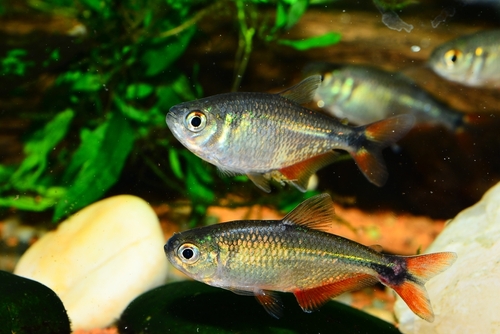Buenos Aires Tetras are sparkling fish that add exotic color to any tank. If you want to give your fish companionable tank mates, add ones that are a similar or larger size than your South American Tetras. While you won’t want to put small fish like Guppies into a Tetra tank, Tetras get along just fine with other same-sized fish who can hold their own in a communal tank.
When considering the perfect Buenos Aires Tetra Tank Mates, think generally non-aggressive fish such as Danios, Barbs, Cichlids, Rams, Loaches, Platy, Gourami, or Tetras who can defend themselves but aren’t likely to get eaten or bully others in the aquarium.
Consider adding any of these 15 fish to a group aquarium to give your Buenos Aires Tetras some company.
Contents
The Best Buenos Aires Tetra Tank Mates
- Sparkling Gourami Tank Mates
- Cherry Barb Tank Mates
- Snowflake Eel Tank Mates
- Bristlenose Pleco Tank Mates
1. Celestial Pearl Danio
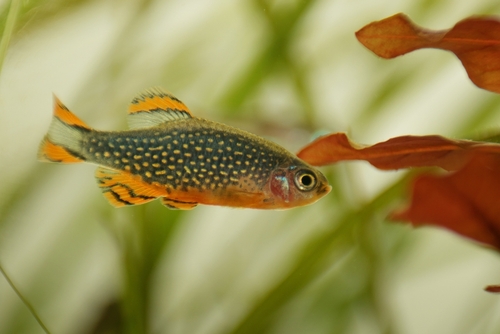
- Scientific name: Danio margaritatus
- Origin: India
- Size: About an inch or so
- Care: Intermediate
A sparkling Celestial Pearl, also called a Galaxy Danio, is a breathtaking choice for a Buenos Aires Tetra tank mate.
They’re not only gentle creatures, but their heavenly blue bodies are sprinkled with shiny pearly white dots like a starry night topped off with setting sunset orange and crimson colors at the caudal fins and tail.
It’s important to ensure that these sensitive fish are kept in a school, have clean, filtered water, many aquatic plants to simulate a natural environment, and a proper diet that combines sinking pellets with fish flakes.
Pros of keeping with Buenos Aires Tetra
- Robust and active
Cons of keeping with Buenos Aires Tetra
- Can tend to nip unless they have a big enough school to socialize with
2. Emperor Tetra

- Scientific name: Nematobrycon palmeri
- Origin: Columbia
- Size: 2 inches
- Care: Easy
If you want an elegant fish with a regal attitude, consider getting an Emperor Tetra for your communal tank. These popular fish have golden fins trimmed in black at the outer edge and scarlet at the belly.
Both male and female fish have bluish-gray color fins with a pale purple wash of color that shimmers underwater. In a design that marks them as kings of their sea, male Emperor Tetras have a tail that is shaped like a trident.
These small freshwater fish are placid and tend to like a lot of thick plants, filtered lighting, and a dark-colored substrate. While they thrive on a peat filter, they can live well in slightly hard water if it is kept nice and clean.
They are quiet omnivores who will happily consume a variety of frozen tidbits, brine shrimp, fish flakes, and daphnia.
Pros of keeping with Buenos Aires Tetra
- Omnivores with a long lifespan
Cons of keeping with Buenos Aires Tetra
- May be prone to some infections and illnesses
3. Rosy Barb

- Scientific name: Pethia conchonius
- Origin: West Bengal and India
- Size: around 4 or so inches
- Care: Easy
Rosy Barb fish are some of the bigger fish of their species that will get along great you’re your Buenos Aires Tetras.
A male Rosy Barb is a fiery display of red and yellow with a splash of black dots that cluster close to its dorsal fin.
Add rocks, some pieces of driftwood, and plants to the tank. Keep them happy and balanced by feeding them a mix of blood worms, brine shrimp, and fish flakes.
Pros of keeping with Buenos Aires Tetra
- Generally non-aggressive and attractive fish
Cons of keeping with Buenos Aires Tetra
- May get nippy if they don’t have a large school
4. Dwarf Gourami
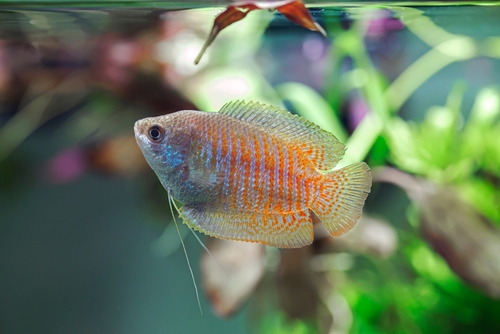
- Scientific name: Trichogaster Ialius
- Origin: Bangladesh
- Size: Around 3 inches
- Care: Moderate
There are a ton of fabulous varieties to choose from when you pick the perfect Dwarf Gourami as your Buenos Aires Tetra tank mate. For instance, there are neon gouramis, powder blue tones, golden shades, gourami that are the orangey-red of a bright sunset, or even rainbow-colored fish.
Since Dwarfs are gentle souls, they won’t bother your tetras. If they have clean water, a precise room temperature, and access to the top of the tank to sip in oxygen, these fish can live a long and peaceful life.
Pros of keeping with Buenos Aires Tetra
- Ready to eat anything
Cons of keeping with Buenos Aires Tetra
- Require very strict water parameters and room temperature needs
5. Dwarf Cichlid
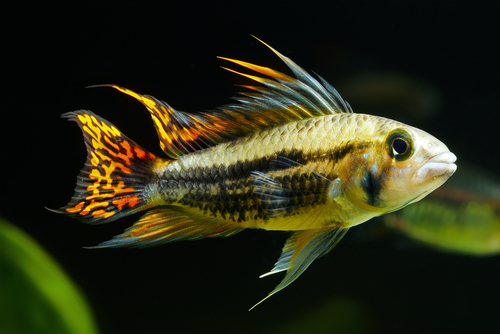
- Scientific name: Apistogramma cacatuoides
- Origin: Brazil
- Size: Close to an inch
- Care: Beginner
A Dwarf Cichlid, aka, the Cockatoo Cichlid, is a flash of blue, gold, and red in the water of a community tank. This docile fish comes in a lot of different colors, so just take your pick. Their long fins are super delicate, so it’s important to pair them with companions who won’t attack them.
This is a fish that will add a lot of interaction and interest to your aquarium. They are curious things that like to roam around their tank and soak it all in. You can stroke your finger along the glass and watch them move along with you.
Just remember to keep them in a small school for socialization, protection, and optimal health. They don’t need a lot of specialized care and can eat worms, tiny brine shrimp, and glass worms.
Pros of keeping with Buenos Aires Tetra
- Low maintenance if they have enough tank space
Cons of keeping with Buenos Aires Tetra
- Might get snapped up by larger or more aggressive species
6. German Blue Ram
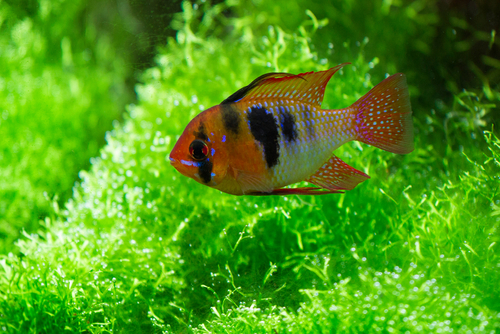
- Scientific name: Mikrogeophagus ramirezi
- Origin: Columbia and Venezuela
- Size: 3 inches
- Care: Moderate
As a small-size cichlid that hails from South America, German Blue Ram fish were once specially bred in Germany, which is where they derive their unique name.
They have bold heads and lips, bodies that shimmer like King Midas’ gold, broad blue vertical strips that run through its body, and long, fragile, fluttering orange caudal fins.
It’s advised to create lots of hiding spaces to provide German Blue Rams with cozy places into which they can tuck themselves. Ensure that water pH and temperatures are precise. Give them sinking pellets, veggie flakes, and some insects to replicate the foods from their natural habitat.
Pro of keeping with Buenos Aires Tetra
- Good community tank dwellers
Cons of keeping with Buenos Aires Tetra
- They don’t have a long lifespan
7. Bolivian Ram Cichlid
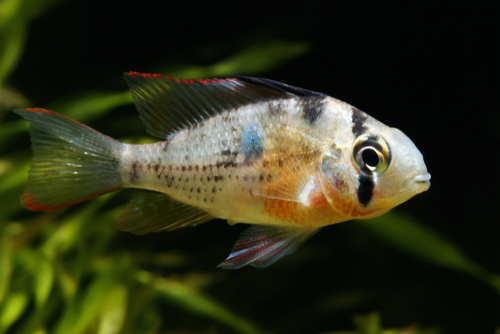
- Scientific name: Mikrogeophagus altispinosu
- Origin: Bolivia
- Size: About 3-plus inches
- Care: Easy
This striking yellow, elongated fish has a black ring around its head, flutter fins that are dipped in crimson, and fishy pale lips. While it’s not aggressive to non-cichlids, it’s a good idea to limit multiple kinds of cichlids in the same tank and keep more females than male fish to decrease conflict.
These interesting fish do not require a lot of precise conditions and will eat anything from worms and shrimp to pellets tossed into their optimal pebbly and sandy substrate environment.
Pros of keeping with Buenos Aires Tetra
- Non-picky omnivores
Cons of keeping with Buenos Aires Tetra
- Sometimes don’t play well with rival cichlids
8. Congo Tetra
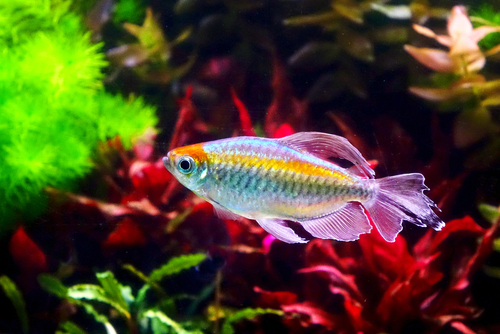
- Scientific name: Phenacogrammus interruptus
- Origin: The Congo
- Size: 3 inches
- Care: Intermediate
A Congo Tetra is a gorgeous tank mate that looks like a hippie rainbow seen through a Valencia filter. They have wide, distinctive caudal and dorsal fins shaped like small, open fans. These fish also range in color from pale neon and yellow central faded lines to opalescent with subtle horizontal bands of orange, blue, and yellow.
Watch out for signs of stress in this species which includes colors that can fade or disappear completely if their needs aren’t met. In an aquarium, they like to consume a range of worms, fish flakes, vegetable matter, and shrimp.
Pros of keeping with Buenos Aires Tetra
- Little maintenance
Cons of keeping with Buenos Aires Tetra
- They can lose their color and fade to a pale brownish color when stressed
9. Rainbowfish
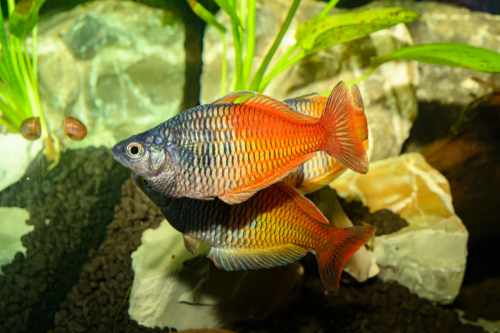
- Scientific name: Melanotaenia boesemani
- Origin: Indonesia
- Size: Around 4 inches
- Care: Generally easy
This fascinating fish appears dipped from head to rear in iridescent emerald-green paint and splashed with brilliant gold tones towards the tail. A Rainbowfish can shift its color tones depending on its health or mood. If you check your fish at night, you’ll notice that their scales have deepened to a richer, deeper green color.
Rainbowfishes have a friendly and non-confrontational temperament which helps them get along famously with tetras, as well as many gouramis, danios, loaches, and barbs.
As omnivorous creatures, Rainbowfish will scoop up anything from algae to krill flakes, pellets, or live meat like daphnia, worms, or shrimp.
Pros of keeping with Buenos Aires Tetra
- Docile, unique, and easy to care for
Cons of keeping with Buenos Aires Tetra
- Tend to get conditions like columnaris
10. Cherry Barb
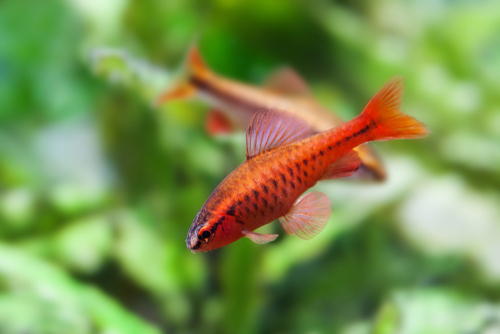
- Scientific name: Puntius titteya
- Origin: Columbia
- Size: At least 2 inches
- Care: Easy
A Cherry Barb is one of the most docile Barb varieties on the planet. That’s what makes it such a good companion for many easygoing species such as Buenos Aires Tetras.
They are not only schooling fish, but they tend to swim more slowly around the tank without causing any trouble.
Check out their brilliant red color, bodies shaped like a torpedo, and long, thin tail that forks at the end. Cherries are not only super adaptable to water parameters, but they are omnivores who enjoy a balanced diet that can range from algae to blood worms.
Pros of keeping with Buenos Aires Tetra
- Interesting to watch and get along with other species
Cons of keeping with Buenos Aires Tetra
- They often get parasitic or bacterial infections in addition to fin rot conditions
11. Zebra Danio
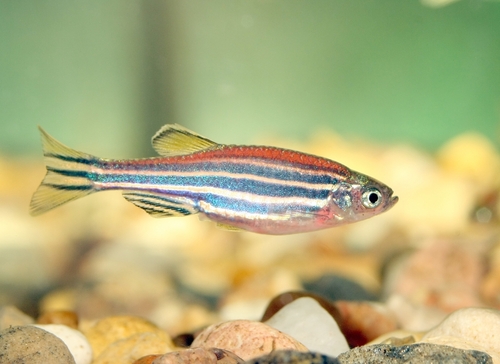
- Scientific name: Brachydanios rerio
- Origin: Indonesia
- Size: Close to 2 inches
- Care level: Easy
Black and white horizontal stripes, in contrast to a zebra’s vertical lines, characterize this interesting swimmer. Just pop a small school of them into your tetra’s community tank and watch them explore the area in a peaceful little gang.
If you want a pet that doesn’t need a lot of attention, Zebras are the way to go. They don’t take up a lot of room and will willingly eat anything from worms to plankton or algae.
Pros of keeping with Buenos Aires Tetra
- Friendly and low maintenance
Cons of keeping with Buenos Aires Tetra
- Can bite other fish with long or delicate fins if stressed
12. Tiger Barb
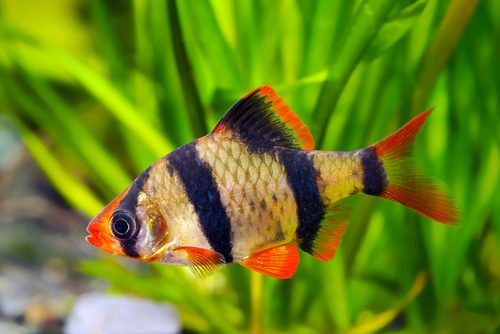
- Scientific name: Puntius tetrazona
- Origin: Sumatra and Borneo
- Size: About an inch or more
- Care: Easy
Who doesn’t love a cool-colored fish that doesn’t need a lot of work? A Tiger Barb is a popular freshwater fish that’s actually a kind of minnow. These small, gentle golden-brown fish have wide black bands across their bodies, and defined, upright caudal fins that are reminiscent of Finding Nemo. Their fins and nose are often tipped with red.
Although Tiger Barbs are omnivorous, you’ll want to ensure that they have access to live brine shrimp, cooked spinach or lettuce, bloodworms, and flakes.
Pros of keeping with Buenos Aires Tetra
- Easy-care omnivore
Cons of keeping with Buenos Aires Tetra
- They can get aggressive with smaller or slower fish
13. Platy Fish

- Scientific name: Poecilia
- Origin: Belize
- Size: Close to 3 or 4 inches
- Care: Easy
Platy fish are a universal favorite when it comes to perfect tank companions for tetras. They get along well with everybody and look beautiful while doing it. Platies are yellow or orange with bright scarlet marks on their face. They also have clusters of black dots that culminate in a thick, elongated, jet-black tail fin.
These aren’t the only colors and shades, so be sure to check out which varieties appeal to you. If you want a fish that doesn’t need a lot of work or a specialized diet, consider a Platy, which enjoys frozen foods, flakes, or worms.
Pros of keeping with Buenos Aires Tetra
- Don’t need a lot of maintenance
Cons of keeping with Buenos Aires Tetra
- Have shorter lifespans
14. Kuhli Loach

- Scientific name: Pangio kuhlii
- Origin: Indonesian islands
- Size: 3-plus or more inches
- Care: Moderate
Kuhli Loaches are peaceful tank mates that are best handled with a little aquarium experience to keep them in optimal health. Their long, pastel-yellow figures are segmented with brownish bands like a snake.
While many tetras like to move around the top of the tank, loaches prefer to spend a lot of time hiding in rocks, plants, or tank décor near the substrate. Since they’re more active and like to swim around the tank fast at night, it’s best to feed them worms and sinking pellets after dark to ensure they get enough to eat.
Pros of keeping with Buenos Aires Tetra
- Excellent for scavenging and cleaning up tanks
Cons of keeping with Buenos Aires Tetra
- May get parasite infections and some other health problems
15. Serpae Tetra
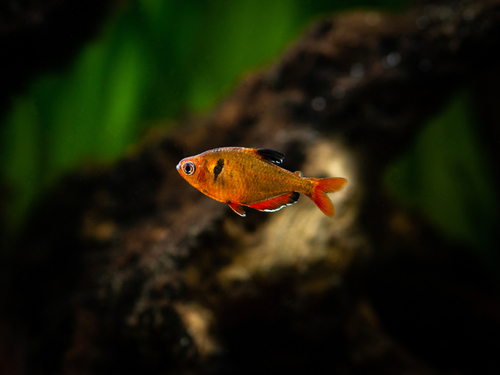
- Scientific name: Hyphessobrycon eques
- Origin: Argentina, Brazil, Bolivia, and Peru
- Size: Around 2 inches
- Care: Easy
This last great tank mate looks like an orange jewel with black caudal and dorsal fins. Serpae Tetras are distinctive fish that are fun to watch. If you’re not familiar with this fish’s unique swimming style, look out for its twitching motions and fast spurting dashes across the aquarium. This normal behavior can add interest to your tank.They are easy-care fish that thrive on a simple diet of blood worms and flakes.
Pros of keeping with Buenos Aires Tetra
- Unique swimming patterns and omnivorous feeding habits
Cons of keeping with Buenos Aires Tetra
- Need specific, soft, and somewhat acidic water conditions to bring out their full-color range
Conclusion
A Buenos Aires Tetra needs water temperatures heated to 72-78 degrees Fahrenheit and neutral or faintly acidic pH water conditions. You will also need to use a slight filter, like a sponge filter, to acquire the proper level of water clarity.
Always add new fish slowly, observe how they interact and adapt, the watch for any signs of stress after putting new tank mates together. If your tank mates get along swimmingly and have their food, water, and other environmental needs met, your fish are more likely to live longer and more peaceful lives.

Ian Sterling, founder of Fishlab.com, began his aquarium journey over 30 years ago, driven by a deep fascination for fish and their diverse personalities. His website, Fishlab.com, is dedicated to making fishkeeping accessible and enjoyable, offering beginner-friendly guidance, expert insights, and a community for aquarists to connect and share experiences.


